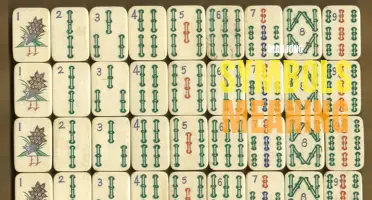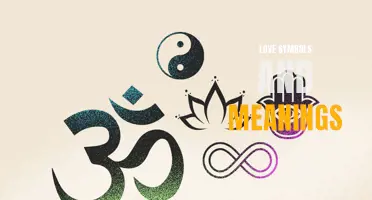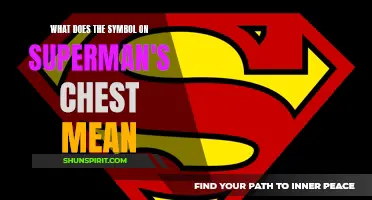
Viking symbol tattoos have deep-rooted meanings that resonate with the strength, courage, and honor associated with the fearless warriors of the North. Each symbol carries its own significance, often representing qualities such as protection, fertility, or the connection between life and death. These tattoos not only serve as impressive works of art but also serve as powerful reminders of the rich Viking heritage and the values that continue to inspire countless individuals today.
What You'll Learn
- What is the significance of Viking symbols in tattoo art?
- Can you explain the meanings behind some commonly used Viking symbols in tattoos?
- Are there any specific Viking symbols that are more popular in tattoos than others?
- Do Viking symbol tattoos have cultural or historical significance, or are they purely aesthetic?
- How can someone incorporate their own personal meaning into a Viking symbol tattoo?

What is the significance of Viking symbols in tattoo art?
Viking symbols have gained popularity in tattoo art due to their rich cultural and historical significance. These ancient symbols are not only visually appealing but also carry powerful meanings that resonate with people from different walks of life. Let's delve into the significance of Viking symbols in tattoo art and explore the various interpretations behind them.
First and foremost, Viking symbols represent the Norse mythology and pagan beliefs of the Vikings, who were seafaring warriors from the late 8th to early 11th century. These symbols often depict their gods, such as Odin, Thor, and Freya, as well as other mythical creatures and concepts. By getting a Viking symbol tattoo, individuals can pay homage to these ancient deities and embrace the values associated with them, such as strength, courage, and wisdom.
One of the most well-known Viking symbols is the Valknut, also known as the "knot of the slain." This symbol consists of three interlocking triangles and is often associated with Odin, the All-Father. The Valknut is believed to symbolize the power to bind and unbind, making it a popular choice for individuals seeking protection and guidance in their lives.
Another significant Viking symbol is the Helm of Awe, also known as Ægishjálmur. This symbol is believed to confer protection and induce fear in one's enemies. Its intricate design often features a central point surrounded by eight spiked arms, creating a visually striking image. Those who choose to ink this symbol on their bodies may seek strength and the ability to overcome obstacles in their lives.
The Mjölnir, also known as Thor's hammer, is another Viking symbol frequently seen in tattoo art. It represents Thor, the god of thunder and strength. The Mjölnir symbolizes protection, power, and the ability to defy the natural order of things. People often get this tattoo as a way to invoke Thor's strength and courage in their own lives.
Runes, the ancient alphabet used by the Vikings, are also popular symbols found in tattoo art. Each rune carries a specific meaning and can be combined to form powerful phrases or mantras. Individuals may choose to get a rune tattoo that represents their name, birthdate, or a word that holds personal significance to them.
In addition to their historical and mythological meanings, Viking symbols also act as a form of self-expression and identity for those who choose to get them tattooed. These symbols are often associated with bravery, exploration, and the indomitable spirit of the Vikings. By wearing these symbols on their skin, individuals connect with their ancestral roots and embrace the warrior spirit within.
In conclusion, Viking symbols hold great significance in tattoo art due to their rich history, mythological associations, and personal meanings. Whether one chooses a Valknut, Helm of Awe, Mjölnir, or rune symbol, each tattoo represents a connection to the Viking culture and its enduring legacy. These symbols not only make for visually striking tattoos but also serve as reminders of the virtues and values associated with the Vikings, such as strength, courage, and wisdom.
Exploring the Rich Symbolism of Sukkot: Understanding the Meaning Behind the Sukkot Symbols
You may want to see also

Can you explain the meanings behind some commonly used Viking symbols in tattoos?
Viking symbols have become increasingly popular in tattoo designs over the years. These symbols hold deep meanings and are often associated with the Viking culture and mythology. Here, we will explore some of the most commonly used Viking symbols in tattoos and their meanings.
- Mjolnir (Thor's Hammer): Mjolnir is one of the most prominent symbols in Viking culture. It represents the hammer of Thor, the Norse god of thunder. This symbol is associated with protection and strength. People often get Mjolnir tattoos to invoke Thor's power and seek protection from harm.
- Valknut: The Valknut is a symbol consisting of three interlocking triangles, often interpreted as a knot. It is associated with Odin, the Allfather of Norse mythology. The Valknut symbolizes honor, bravery, and the connection between the living and the dead. Some people believe it can also be a representation of the afterlife.
- Vegvisir: The Vegvisir, also known as the Viking compass, is a symbol believed to guide the wearer through rough waters and help them find their way home. It is often seen as a talisman for protection and guidance. People getting Vegvisir tattoos often use it as a symbol of finding their path in life or overcoming challenges.
- Helm of Awe (Aegishjalmur): The Helm of Awe is a powerful symbol worn between the eyes or on the forehead for protection and strength. It is believed to create a sense of awe and fear in one's enemies. People often choose this symbol as a reminder of their inner strength and resilience.
- Yggdrasil: Yggdrasil, the World Tree, is a symbol that represents the Norse cosmology and the interconnectedness of all things. It is often depicted as a massive ash tree with its roots intertwined with the different realms of existence. Yggdrasil is associated with life, growth, and wisdom. Getting a Yggdrasil tattoo can signify a connection to nature and the importance of personal growth.
- Runes: Runes were the ancient alphabet used by the Vikings and have now become popular symbols in tattoo designs. Each rune carries a specific meaning and can be combined to convey different messages. People often get runic tattoos with words or phrases that hold personal significance to them.
When considering a Viking symbol for a tattoo, it is important to understand its significance and ensure it resonates with one's personal beliefs and values. Taking the time to research and find the symbol that holds the most meaning can result in a powerful and deeply personal tattoo. Remember, these symbols are not just aesthetic designs but representations of a rich and complex culture.
Decoding the Lexus Car Dashboard Symbols and Their Meanings
You may want to see also

Are there any specific Viking symbols that are more popular in tattoos than others?
Viking symbols have become increasingly popular tattoos in recent years. The Viking culture is rich with mythology, history, and symbolism, making their symbols a popular choice for those looking for meaningful and powerful designs. While there are numerous Viking symbols to choose from, there are a few that have gained more popularity than others in the tattoo world.
One of the most iconic Viking symbols is the Thor's Hammer, also known as Mjolnir. This is the symbol of Thor, the god of thunder, and is often associated with strength, protection, and fertility. The Thor's Hammer tattoo is a popular choice for those looking to showcase their own strength and power.
Another popular Viking symbol is the Vegvísir, which is often referred to as the Viking Compass. This symbol is believed to guide the wearer through rough seas and difficult times, providing protection and guidance. The Vegvísir is a beautiful and intricate symbol, making it a popular choice for those looking for a visually striking tattoo.
The Valknut, also known as the Knot of the Slain, is another popular Viking symbol in tattoos. This symbol is often associated with Odin, the king of gods, and represents his power and connection to the warrior afterlife. The Valknut is a symbol of bravery and sacrifice, making it a meaningful choice for those who want to honor their warrior ancestors.
The Helm of Awe, or Ægishjálmr, is a Viking symbol that is often chosen for its powerful and intimidating appearance. This symbol is believed to offer protection and instill fear in one's enemies, making it a popular choice for those who want to showcase their strength and bravery.
Lastly, the Raven is a popular Viking symbol often associated with Odin. Ravens were believed to be messengers between the human world and the god's realm. The raven tattoo is a popular choice for those who want to symbolize wisdom, power, and connection to the spiritual realm.
While these are just a few of the more popular Viking symbols for tattoos, there are numerous others to choose from. Whether you are drawn to the strength and power of Thor's Hammer, the guidance and protection of the Vegvísir, or the bravery and sacrifice of the Valknut, Viking symbols offer a wealth of meaning and symbolism for those looking to get a tattoo that represents their connection to the Viking culture.
The Meaning Behind Kyrie Irving's Infinity Symbols
You may want to see also

Do Viking symbol tattoos have cultural or historical significance, or are they purely aesthetic?
Viking symbol tattoos have gained popularity in recent years, with many individuals choosing to adorn their bodies with these ancient designs. But do these tattoos hold any cultural or historical significance, or are they purely chosen for their aesthetic appeal?
The Vikings were a seafaring people from the late eighth to early 11th century, originating in what is now modern-day Scandinavia. They were known for their intricate artwork and storytelling traditions, which often included the use of symbols.
One of the most commonly recognized Viking symbols is the Vegvisir, also known as the Viking compass. This symbol is said to offer protection and guidance to those who wear it. It is believed to have been used by Vikings as a navigational aid during their long voyages.
Another popular Viking symbol is the Valknut, which depicts three interlocking triangles. This symbol is associated with Norse mythology and is often associated with Odin, the Allfather. It is believed to represent the interconnectedness of the nine worlds in Norse cosmology.
Other Viking symbols, such as the Mjolnir (Thor's hammer) and the Helm of Awe, also hold significant meaning in Norse mythology. These symbols are often chosen for their connection to the gods and their perceived strength and protection.
While many individuals choose Viking symbol tattoos for their aesthetic appeal, these designs have deep cultural and historical significance. They represent the values and beliefs of the ancient Viking people and serve as a connection to their rich mythology and traditions.
For those who choose to get Viking symbol tattoos, it is important to understand the meaning behind these designs and to respect the culture from which they originated. These symbols should not be taken lightly or used purely for decorative purposes.
In conclusion, Viking symbol tattoos hold both cultural and historical significance. They are not purely chosen for their aesthetic appeal but rather as a way to connect with the ancient Viking culture and their mythology. It is important for individuals who choose to get these tattoos to understand and respect the meaning behind these symbols to honor their cultural and historical significance.
Understanding the Meanings Behind Witchcraft Symbols
You may want to see also

How can someone incorporate their own personal meaning into a Viking symbol tattoo?
Viking symbols are popular choices for tattoos due to their rich history and powerful meanings. Whether you have Viking ancestry or are drawn to the symbolism, incorporating your own personal meaning into a Viking symbol tattoo can make it even more meaningful.
- Research Viking symbols: Start by familiarizing yourself with the different Viking symbols and their meanings. Some popular symbols include the Valknut, Mjolnir (Thor's hammer), Vegvisir, and Helm of Awe. Each symbol has its own significance and can represent various aspects of Viking culture, mythology, and values.
- Reflect on your personal values: Think about what values are important to you and how they align with Viking symbolism. For example, if you value strength and protection, the Mjolnir symbol might be a good choice. If you seek guidance and direction, the Vegvisir could be a meaningful symbol to incorporate.
- Connect with your heritage: If you have Viking ancestry, consider exploring your family history and incorporating elements that reflect your heritage into the tattoo. This could include symbols specific to your ancestral region or incorporating traditional Viking patterns or designs.
- Customize the symbol: To further personalize your tattoo, consider adding elements that hold personal meaning to you. This could be a name, a significant date, or even symbols that represent aspects of your personality or life experiences. Work with a skilled tattoo artist who can help create a design that incorporates these elements seamlessly into the Viking symbol.
- Symbol placement: Think about where you want to place your tattoo and how it will flow with your body. Consider the size and shape of the chosen symbol and how it will complement your existing tattoos or other body art if you have any. Placement can also have personal meaning, such as choosing a symbol of protection on an area of your body that is vulnerable or connected to a specific aspect of your life.
- Seek professional guidance: Consult with a professional tattoo artist who specializes in Viking symbols and can help bring your vision to life. They can provide valuable input on the design, placement, and sizing, ensuring that your personal meaning is incorporated effectively into the tattoo.
Remember, a tattoo is a personal expression of yourself, and incorporating your own personal meaning into a Viking symbol tattoo can make it unique and deeply meaningful. Take your time to research, reflect, and work closely with a skilled artist to create a design that represents your values, heritage, and personal experiences.
Decoding the Mystical Meanings Behind Goth Symbols
You may want to see also
Frequently asked questions
The Viking symbol tattoo holds significant meaning. The symbols represent various elements of Viking culture and mythology. Some common Viking symbols include the Valknut, which symbolizes protection and guidance, and the Mjolnir, which represents strength and fertility. Each symbol carries its own unique meaning, allowing individuals to choose a tattoo that resonates with their personal beliefs and values.
The Valknut symbol, also known as Odin's Knot, is a popular Viking symbol tattoo choice. It is commonly associated with protection, guidance, and the afterlife. The three interlocking triangles represent the connection between the gods and the earthly realm, as well as the cycle of life, death, and rebirth. Many individuals choose to incorporate the Valknut into their tattoo design to symbolize their connection to Norse mythology and honor the bravery and strength of the ancient Vikings.
The Mjolnir, also known as Thor's Hammer, is another commonly seen Viking symbol tattoo. It symbolizes strength, protection, and fertility. The hammer is said to have the power to destroy, but also the power to create. As a tattoo design, the Mjolnir represents the wearer's personal strength, determination, and ability to overcome obstacles. It is often seen as a talisman of courage and is a popular choice for those who seek to embody the warrior spirit of the Vikings.
Yes, there are several other popular Viking symbol tattoos aside from the Valknut and Mjolnir. The Helm of Awe, also known as the Ægishjálmur, is a symbol of protection and strength. It was believed to be able to induce fear and protect its wearer from harm. The Vegvísir, or Norse compass, is another popular symbol that represents guidance and finding one's way in life. These are just a few examples, but there are many more Viking symbols to choose from, each with their own unique meanings and symbolism.
Absolutely! One of the great things about Viking symbol tattoos is that they can be personalized to reflect your own beliefs, values, and experiences. You can incorporate other elements into your design, such as animals, knots, or runes, to create a truly unique and meaningful tattoo. Many people also choose to add names or dates to their Viking symbol tattoos to pay homage to loved ones or commemorate special events. The possibilities are endless, and a skilled tattoo artist can work with you to create a design that is both visually appealing and personal to you.







